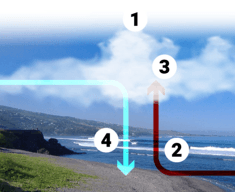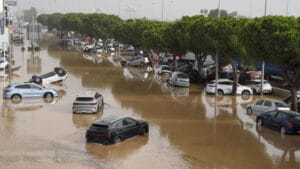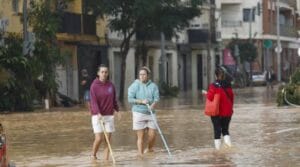Floods in Spain Come in Autumn
Spain is one of the most attractive destinations in Europe for retirees, thanks to its Mediterranean lifestyle, warm climate, and rich culture. Yet, those considering settling here should be aware of one particular seasonal phenomenon: the DANA (Depresión Aislada en Niveles Altos, Isolated Depression at High Levels). This event can cause severe floods in Spain during September and October, especially along the Mediterranean coast.
What is DANA?
DANA, sometimes referred to as the modern version of the old term gota fría (“cold drop”), is a meteorological event that occurs when a pocket of very cold air in the upper atmosphere becomes isolated from the main jet stream. This isolated depression hovers over the Iberian Peninsula and interacts with the warm, humid air rising from the Mediterranean Sea.
When these two forces meet, the result is often violent thunderstorms and torrential downpours. In just a few hours, some areas can receive more rain than they normally see in an entire year. Because of this intensity, DANA is often compared to tropical storm systems, though its origin is different.
- A very cold polar air mass is isolated. It circulates at an altitude of 5,000 to 9,000 meters.
- The warm, humid air from the surface rises.
- As it rises, it condenses and forms clouds.
- The cold air descends and pushes the warm air away. Storms form.

DANA vs. Gota Fría: What’s the Difference?
For decades, many people in Spain used the term gota fría (“cold drop”) to describe the heavy autumn storms that bring torrential rain and flooding to the Mediterranean coast. Today, however, meteorologists prefer the term DANA, which stands for Depresión Aislada en Niveles Altos (Isolated Depression in High Levels).
Although the two concepts are closely related, there are important differences:
- Gota fría (old term):
Traditionally, “gota fría” was a popular expression, not a precise scientific definition. It referred generally to the extreme rainstorms that often hit eastern Spain in autumn. Over time, the phrase became associated more with the consequences — flooding, swollen rivers, and damaged towns — than with the actual meteorological cause. - DANA (modern term):
A DANA is a specific meteorological phenomenon: an isolated pocket of cold air that breaks away from the jet stream at high altitude. When it encounters warm, moist air from the Mediterranean, it can generate severe instability, thunderstorms, and torrential rainfall. Unlike gota fría, DANA refers precisely to the cause of these weather events, not just their effects.
Why the Change?
Meteorologists adopted “DANA” in recent years because it is scientifically accurate and avoids the confusion created by the old phrase. While the term gota fría is still used informally in the media and everyday conversation, experts now insist on using DANA to describe the phenomenon correctly.
- Gota fría → colloquial, focuses on the effects (floods, destruction).
- DANA → technical, focuses on the cause (isolated cold air depression).
Why September and October?
The autumn months are the peak season for DANA-related floods because the Mediterranean retains the summer’s heat well into September and October. Warm sea surface temperatures act like fuel, releasing large amounts of moisture into the atmosphere. When a DANA arrives, this warm, moist air collides with the colder air aloft, creating explosive instability.
Geography plays a role too. Mountain ranges near the coast, such as those in Valencia, Murcia, and Alicante, force humid air upwards, intensifying rainfall. The combination of warm water, cold air, and coastal mountains makes the Spanish Mediterranean particularly vulnerable.
Recent Examples
In October 2024, Spain suffered one of the worst DANAs in modern history. The Valencia region recorded extraordinary rainfall: some areas exceeded 700 liters per square meter in just a few days. Entire towns were submerged, rivers burst their banks, and flash floods swept through streets.
The human toll was devastating. Official data said 236 lives were lost, and thousands of homes were damaged. The Spanish government declared three days of national mourning, and the military was deployed to help with rescue and recovery operations. This tragic event served as a stark reminder of the destructive power of DANA.




The Role of Climate Change
Experts warn that DANAs are becoming more dangerous due to climate change. The Mediterranean is warming faster than the global average, increasing the amount of moisture in the atmosphere. Studies suggest that rainfall during these storms can now be 10–15% heavier than it would have been decades ago, and sea surface temperatures in the region are up to 4°C higher than in the past.
This means that while DANA is not a new phenomenon, its impacts are now more severe. Retirees moving to Spain should understand that what used to be considered rare, “once-in-a-generation” floods are now expected to occur more frequently.
Safety and Preparedness
For those retiring in Spain, awareness and preparation are key. Here are some practical tips:
- Stay informed: The Spanish emergency service (dial 112) issues real-time alerts. Pay attention to official weather warnings, especially in September and October.
- Avoid risky areas: Floods hit hardest in low-lying areas, riverbanks, and underground garages. When looking for property, it’s worth checking the flood risk of the location.
- Have an emergency plan: Know evacuation routes and keep essentials like bottled water, torches, and documents in an accessible place.
- Insurance and infrastructure: Ensure your home insurance covers flood damage. Spain has a state-backed compensation scheme for extraordinary risks, but private coverage is highly recommended.
Check state meteorological agency for more information, in English.
Living with DANA
While DANAs can be dramatic, they are limited in time and geography. Millions of people live safely in Spain’s Mediterranean regions, and local authorities are increasingly investing in flood defenses, early warning systems, and resilient urban planning.
For retirees, the key is not to be discouraged but to be informed. Just as California residents prepare for wildfires or Florida residents for hurricanes, those who retire in Spain’s coastal regions should understand the seasonal risks of DANA. With preparation and awareness, it is entirely possible to enjoy the many benefits of Mediterranean life while staying safe during storm season.
